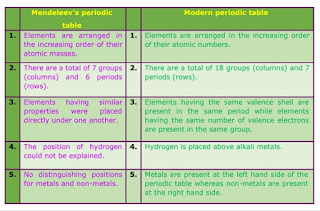NCERT solution class 10 Science Chapter 5 || Periodic Classification of Elements || Chemistry || Science ||
Ques 1: Which of the following statements is not a correct statement about the trends when going from left to right across the periods of periodic Table.
(a) The elements becomes less metallic in nature.
(b) The number of valence electrons increases.
(c) The atoms lose it's electrons more easily.
(d) The oxides become more acidic.
Ans 1: (c) The atoms lose their electrons more easily as compare to the others. (On moving left to right across the periods of the periodic table, the non-metallic character increases. Hence, the tendency of lossing electrons decreases.)
Ques 2: Element X forms a chloride with the formula XCl2, which is a solid with a high melting point. X would most likely be in the same group of the Periodic Table as
(a) Na
(b) Mg
(c) Al
(d) Si
Ans 2: (a) X would most likely be in the same group of the Periodic Table as of magnesium (Mg).
Ques 3: Which element has
(a) two shells, both of which are completely filled with electrons?
(b)the electronic configuration 2, 8, 2?
(c) a total of three shells, with four electrons in its outermost shell?
(d)a total of two shells, with three electrons in its outmost shell?
(e) twice as many electrons in its second shell as in the first shell?
Ans 3: (a)Neon(Ne) has two shells, both of which are completely filled with electrons (2 electrons in K shell and 8 electrons in L shell).
(b)Magnesium(Mg) has the electronic configuration 2, 8, 2. or [1s² 2s² 2p 3s²].
(c) Silicon(Si) has a total of three shells, with four electrons in its valence shell (2 electrons in K shell, 8 electrons in L shell and 4 electrons in M shell). (2,8,4)
(d) Boron has a total of two shells, with three electrons in its valence shell (2 electrons in K shell and 3 electrons in L shell). (2,3)
(e) Carbon has twice as many electrons in its second shell as in its first shell (2 electrons in K shell and 4 electrons in L shell).
Ques 4: (a)What property do all elements in the same column of the Periodic Table as boron have in common?
(b) What property do all elements in the same column of the Periodic Table as fluorine have in common?
Ans 4: (a)All the elements in the same column as Boron(B) have the same number of valence electrons (3). Hence, they all have valency equal to 3.
(b)All the elements in the same column as fluorine have the same number of valence electrons (7). Hence, they all have valency equal to 1.
Ques 5: An atom has electronic configuration 2, 8, 7.
(a)What is the atomic number of this element?
(b)To which of the following elements would it be chemically similar? (Atomic numbers are given in parentheses.) N(7), F(9), P(15), Ar(18)
Ans 5: (a) The atomic number of this element is 17 which is chlorine (Cl).
(b) It would be chemically similar with Flourine F(9) with configuration as 2, 7.
Ques 6: The position of three elements A, B and C in the Periodic Table are shown below −
Ans: (a) A is a non-metal.
(b) C is lesser reactive than A, as reactivity decreases down the group in halogens.
(c) C will be smaller in size as compare to B as moving across a period, the nuclear charge increases and therefore, electrons come closer to the nucleus.
(d) A will form an anion(negatively charged ions) as it accepts an electron to complete its octet.
Ques 7: Nitrogen having (atomic number 7) and phosphorus having (atomic number 15) belong to group 15 of the Periodic Table. Write the electronic configuration of these two elements. Which of these will be more electronegative? And Why?
Nitrogen is more electronegative than phosphorus. {Electronegativity series you will study in class 11}. On moving down the group, the number of shell increases. Therefore, the valence electrons move away from the nucleus and the effective nuclear charge decreases. This causes the decrease in tendency to attractQues 8: How does the electronic configuration of an atom relate to its position in the Modern Periodic Table?
Ans 8: In the modern periodic table, atoms with similar electronic configurations are placed in the same column column. In a group, the number of outermost electrons remains the same. Elements across a period show an increase in the number of outermost electrons.
Ques 9: In the Modern Periodic Table, calcium Ca(atomic number 20) is surrounded by elements with atomic numbers 12, 19, 21, and 38. Which of these have physical and chemical properties resembling calcium(Ca)?
Ans 9: The element with atomic number 12 which is Magnesium has same chemical properties as that of calcium. This is because both of them have same number of outermost electrons (2).
Ques 10: Compare and contrast the arrangement of elements in Mendeleev’s periodic Table and the Modern Periodic Table.
Ans:




Comments
Post a Comment